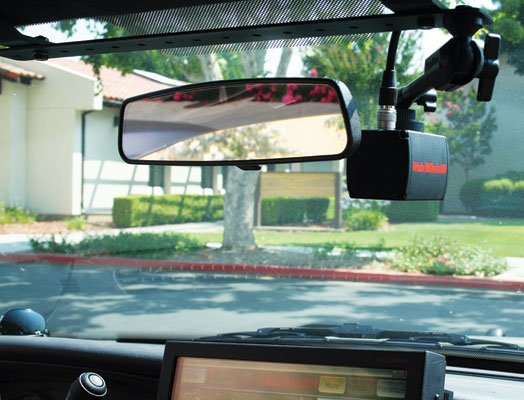If
”
America’s Wildest Chases Caught on Tape
”
has taught America anything, it is that even routine traffic
stops get recorded. But that’s a TV show
– Gilroy and neighboring law enforcement agencies are much
different.
the camera and its capabilities.
If “America’s Wildest Chases Caught on Tape” has taught America anything, it is that even routine traffic stops get recorded. But that’s a TV show – Gilroy and neighboring law enforcement agencies are much different.
Only one of the Gilroy Police Department’s 35 vehicles has a camera mounted on the inside of the windshield. The Santa Clara Sheriff’s Office has cameras in all of its vehicles, as does the San Benito Sheriff’s office, which even has lenses and microphones in officers’ TASERS. But the California Highway Patrol and the police departments of Morgan Hill and Hollister lack cameras – let alone seeing TASERS – for financial reasons, spokespersons reported.
But money is not the issue here in Gilroy: It’s one of prudence, said Sgt. Jim Gillio.
Police have had such a troublesome and costly experience with the last in-car computer-camera manufacturer, SecureEye, that they want to be careful this time. Gilroy ended up paying about $440,000 for the old equipment that sapped car batteries and left screens blinking, another $50,000 to fix and replace some of that technology dating back to 2004.
Throughout the past year, though, the department has rectified the situation by spending another $450,000 to install 31 sleek, touch-screen computer systems. Each new system manufactured by Alameda-based Data911 Mobile Computer Systems costs about $14,000. But incorporating the camera component – which is included in the cost – will take a bit longer as officers continue testing the waters, Gillio said.
“We had to take a step back and work out all the bugs in the old system, so now we’re being careful and deliberate to make sure the new system works as planned,” Gillio said. There is no timeline for adding cameras to the 31 vehicles with computers. Four command staff vehicles will not get new technology.
While the spotty technology drew attention all by itself last summer, it became a bigger issue after Pete Joseph Valdez III allegedly tried to shoot Gilroy officer John Ballard in the face during a brief foot chase. Four cars responded to the Nov. 15 incident, including Ballard’s, but he did not have a camera in his vehicle, according to Gillio; and although two of the cars that followed had SecureEye cameras, they were not working correctly or were not being used at all, according to the city’s IT Director, David Chulick said.
While that may be the case, matters became more complicated when Valdez’s private attorney, Berndt Ingo Brauer, requested video footage related to the incident, only to discover the records may be gone.
Between Nov. 12 and Dec. 7, the city’s IT department moved the physical video databases from the old police department to the new one. During the move, an employee removed some of the heavy disk drives from their shelving units to make their transportation easier, but that person did so without noting their specific order. Reinserting the drives out of order corrupts the data, but luckily somebody caught the mistake before it was too late, Chulick said.
“It was a case of unfortunate oversight … People make human mistakes, and we work around that,” Chulick said.
The city spent about $7,000 to send the discs to a data recovery company that identified the correct order. Chulick received those discs earlier this week and said he planned to see if, in fact, there was any footage from the Valdez incident.
But were the SecureEye cameras in the two of the four cars that showed up for Valdez capturing any data, and if so was the alleged scuffle within frame?
Based on correspondence with Gilroy police, Deputy District Attorney Mark Hood said he understands the cameras were not working. But if the cameras that November morning were rolling, then great, Hood said.
“My understanding is that there was no video evidence to begin with,” Hood said, “But I’ll welcome any new discovery.”
In fact, having tape in court cases is why law enforcement agents said they love having cameras.
“It’s great evidence,” San Benito County Sheriff’s Office Lt. Roy Iler said. The department has cameras in all 12vehicles, he said. The installations wrapped up last year.
The Santa Clara County Sheriff’s Office has been one of the pioneering agencies when it comes to cameras, said Sgt. Don Morrissey. For about 10 years the office has cycled through three or four systems, continually improving its audio and visual recording capabilities, Morrissey said.
“The cameras are invaluable. We have to paint a picture of the incident for the judge, the prosecution and even the defense, and the cameras can only help that,” he said.
Technology has come far enough to even allow officers to wear cameras on their person, either pinned to their lapel or one of their buttons. Morgan Hill Police Department Commander David Swing mentioned this technology, but the agency to the north said good-bye to its first and only camera more than five years ago when grant money ran out. Now the department is working to find another grant.
In Hollister there are similar financial woes.
“Having cameras in a vehicle is a good thing for everyone,” Hollister Police Department Personnel and Community Services officer Rosie Betanio said. Three years ago the department had cameras in its fleet of about 30, she said, but that technology malfunctioned. “Hopefully we’ll get some if we can ever afford it,” Betanio said.
Having the money and spending it prudently are two different things, so Gilroy will tread slowly.














